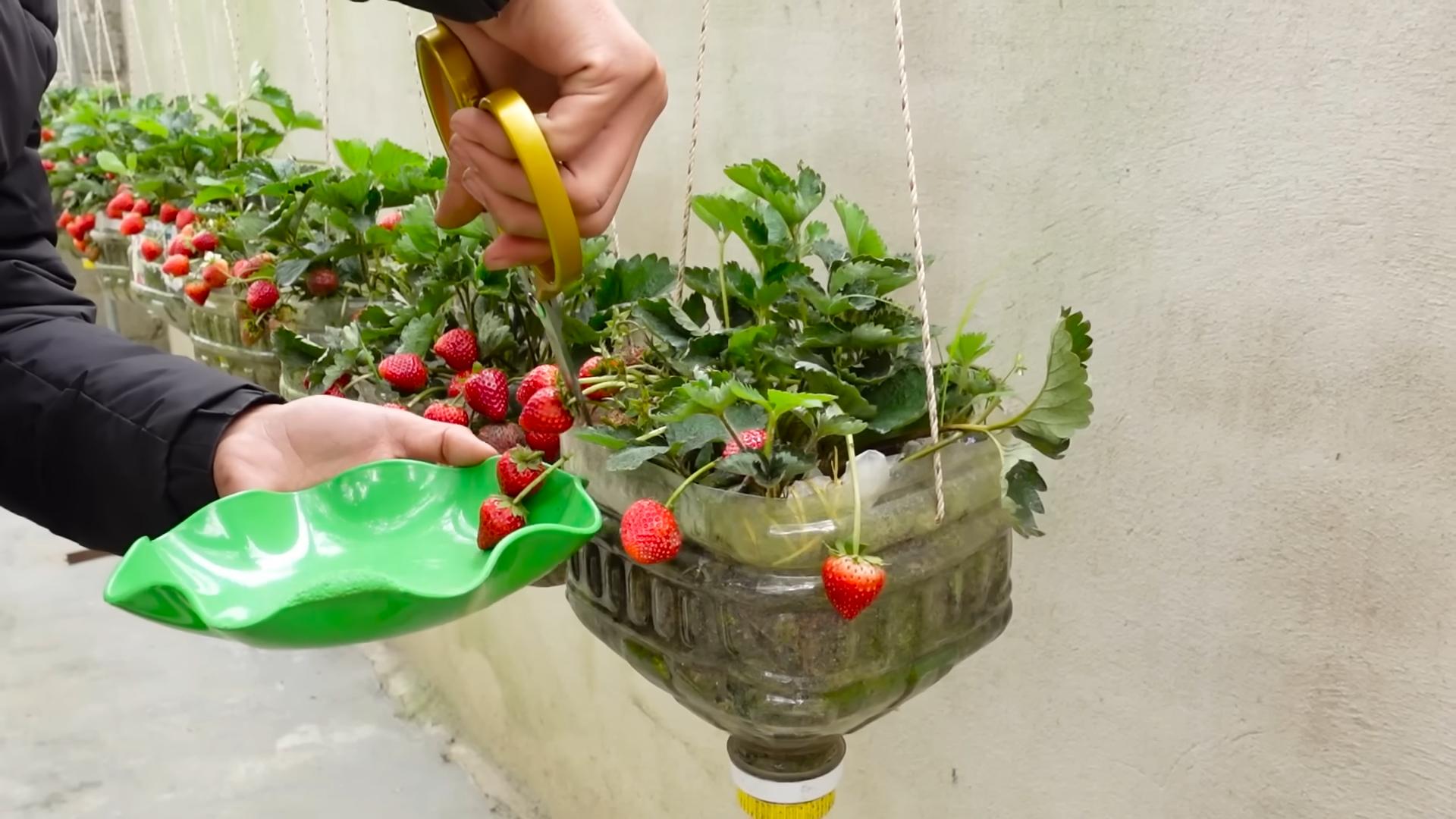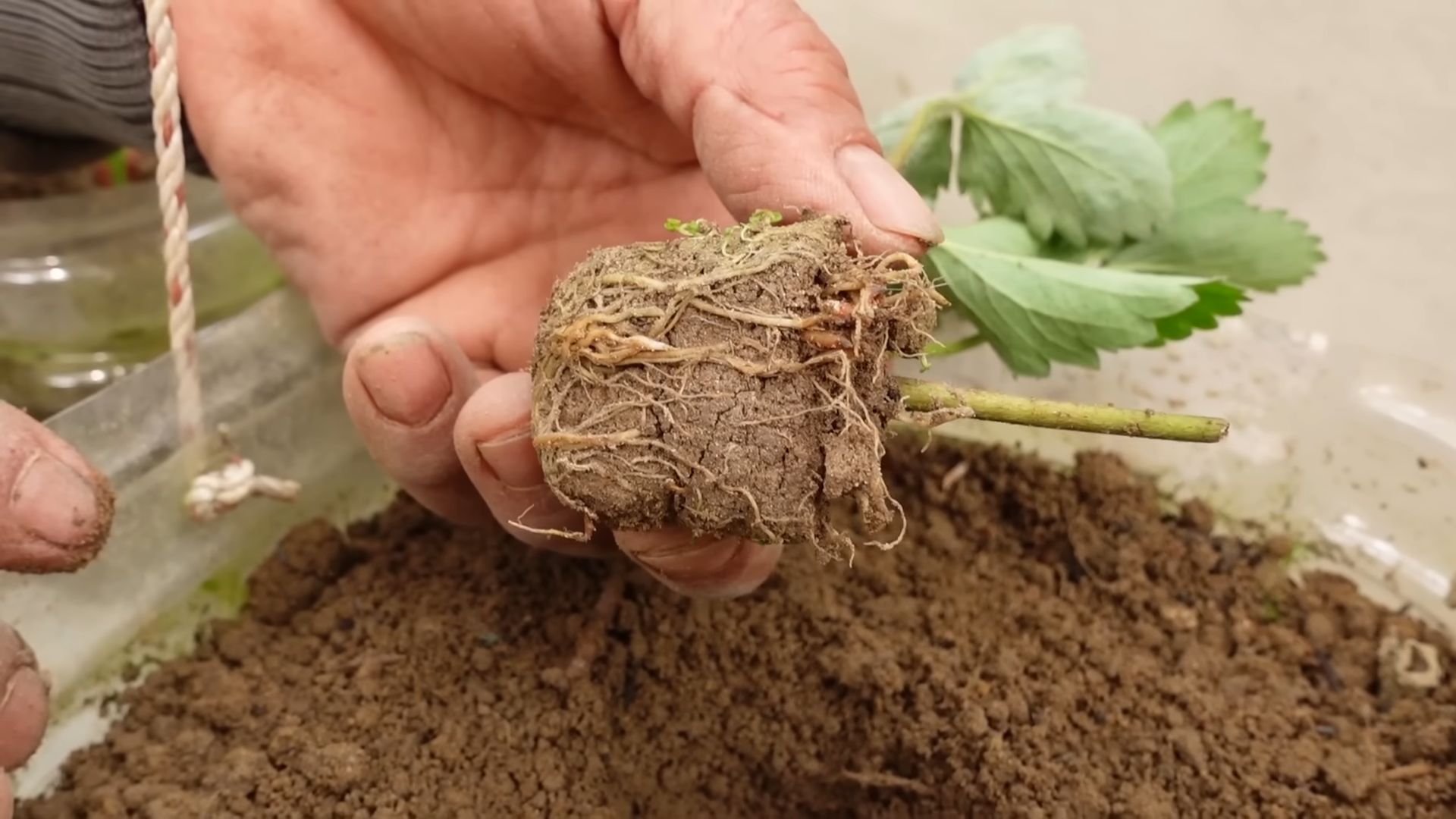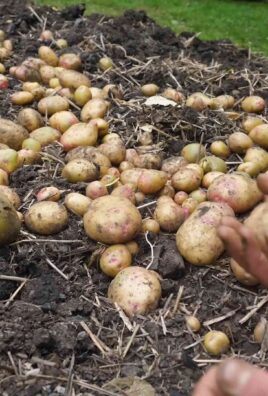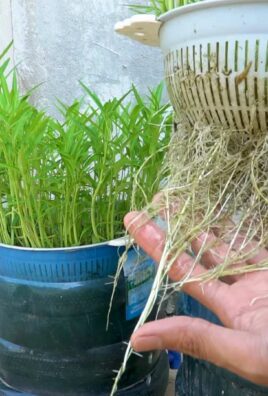Grow Strawberries at Home – imagine plucking juicy, sun-ripened strawberries straight from your own garden! Forget those bland, store-bought berries; we’re diving into the wonderful world of DIY strawberry cultivation. For centuries, strawberries have been cherished, not just for their delicious taste, but also for their vibrant color and nutritional benefits. From ancient Roman gardens to medieval monastery plots, these little red gems have a rich history, symbolizing love, purity, and healing.
But why should you bother with growing your own? Well, let’s be honest, who doesn’t love fresh strawberries? More importantly, knowing exactly where your food comes from is incredibly empowering. Plus, it’s a fantastic way to connect with nature and enjoy the therapeutic benefits of gardening. This DIY guide is packed with simple, effective tricks and hacks that will help you grow strawberries at home, even if you have limited space or a less-than-green thumb. I’m going to show you how to avoid common pitfalls, maximize your yield, and enjoy a bountiful harvest of sweet, delicious strawberries all season long. Get ready to transform your backyard, balcony, or even a sunny windowsill into a strawberry paradise!

Growing Strawberries at Home: A Beginner’s Guide
Hey there, fellow gardening enthusiasts! Ever dreamt of plucking juicy, red strawberries straight from your own backyard? Well, dream no more! Growing strawberries at home is surprisingly easy and incredibly rewarding. I’m going to walk you through everything you need to know, from choosing the right variety to harvesting your delicious bounty. Let’s get started!
Choosing Your Strawberry Variety
Before you even think about planting, you need to decide which type of strawberry is right for you. There are three main types:
* June-Bearing: These strawberries produce one large crop, usually in late spring or early summer (hence the name!). They’re great if you want a big batch for jam-making or freezing.
* Everbearing: Don’t let the name fool you – everbearing strawberries don’t produce fruit continuously. Instead, they have two or three harvests per year, typically in spring, summer, and fall.
* Day-Neutral: These are the most consistent producers, yielding fruit throughout the growing season as long as the temperature is between 35-85°F. They’re perfect for a steady supply of fresh berries.
Consider your climate, available space, and desired harvest schedule when making your choice. I personally love day-neutral varieties because I enjoy having fresh strawberries all summer long!
Preparing Your Strawberry Patch
Strawberries need a sunny spot and well-drained soil to thrive. Here’s how to get your planting area ready:
1. Choose a Sunny Location: Strawberries need at least 6-8 hours of sunlight per day. The more sun, the sweeter the berries!
2. Test Your Soil: A soil test will tell you the pH level and nutrient content of your soil. Strawberries prefer slightly acidic soil with a pH between 5.5 and 6.8. You can purchase a soil testing kit at most garden centers or send a sample to your local agricultural extension office.
3. Amend the Soil: Based on your soil test results, amend the soil as needed. If your soil is too alkaline, you can add sulfur or peat moss to lower the pH. If it’s lacking in nutrients, incorporate compost, aged manure, or a balanced fertilizer. I always recommend using organic amendments whenever possible.
4. Ensure Good Drainage: Strawberries hate soggy feet! If your soil is heavy clay, amend it with plenty of organic matter to improve drainage. You can also consider planting in raised beds or containers.
5. Remove Weeds: Clear the planting area of all weeds and grass. Weeds compete with strawberries for nutrients and water, so it’s important to get rid of them before planting. You can use a hoe, hand-pull them, or apply a pre-emergent herbicide.
Planting Your Strawberries
Now for the fun part – planting! Whether you’re starting with bare-root plants or potted strawberries, the process is pretty straightforward.
1. Soak Bare-Root Plants: If you’re using bare-root plants, soak the roots in water for about an hour before planting. This will help rehydrate them and give them a good start.
2. Dig Holes: Dig holes that are large enough to accommodate the roots of your strawberry plants. Space the holes about 12-18 inches apart in rows that are 2-3 feet apart.
3. Plant Carefully: When planting, make sure the crown of the plant (the point where the roots meet the stem) is level with the soil surface. Planting too deep can cause the crown to rot, while planting too shallow can dry out the roots.
4. Spread the Roots: Gently spread the roots out in the hole before backfilling with soil.
5. Water Thoroughly: After planting, water the strawberries thoroughly to settle the soil and help the roots establish.
6. Mulch: Apply a layer of mulch around the plants to help retain moisture, suppress weeds, and keep the berries clean. Straw, pine needles, or wood chips are all good options.
Caring for Your Strawberry Plants
Once your strawberries are planted, it’s important to provide them with the care they need to thrive.
1. Water Regularly: Strawberries need consistent moisture, especially during fruit production. Water deeply whenever the top inch of soil feels dry. Avoid overhead watering, as this can promote fungal diseases. Drip irrigation or soaker hoses are ideal.
2. Fertilize: Fertilize your strawberries every few weeks with a balanced fertilizer or a fertilizer specifically formulated for berries. Follow the instructions on the fertilizer package.
3. Weed Control: Keep the planting area free of weeds by hand-pulling or using a hoe. Mulch will also help suppress weed growth.
4. Pest and Disease Control: Keep an eye out for common strawberry pests and diseases, such as aphids, spider mites, slugs, and fungal diseases. Treat any problems promptly with appropriate organic or chemical controls.
5. Renovate June-Bearing Strawberries: After the harvest, June-bearing strawberries need to be renovated to maintain their productivity. Mow the plants down to about an inch above the crown and thin out the rows. This will encourage new growth and a better harvest the following year.
6. Protect from Birds: Birds love strawberries just as much as we do! Protect your berries with netting or other bird deterrents. I’ve found that shiny reflective tape also works well to scare them away.
7. Remove Runners (for Everbearing and Day-Neutral): Everbearing and day-neutral strawberries produce runners (stems that grow horizontally and develop new plants). To maximize fruit production, remove these runners regularly. You can either pinch them off or transplant them to create new strawberry plants.
Harvesting Your Strawberries
The moment you’ve been waiting for – harvesting your delicious strawberries!
1. Pick When Ripe: Strawberries are ready to harvest when they are fully red and easily pull away from the plant.
2. Harvest in the Morning: The best time to harvest strawberries is in the morning, after the dew has dried.
3. Handle Gently: Strawberries are delicate, so handle them gently to avoid bruising.
4. Store Properly: Store unwashed strawberries in the refrigerator for up to a week. Wash them just before eating.
Growing Strawberries in Containers
Don’t have a lot of space? No problem! Strawberries grow beautifully in containers.
1. Choose the Right Container: Select a container that is at least 12 inches in diameter and 8 inches deep. Hanging baskets, strawberry pots, and window boxes are all great options.
2. Use a Good Potting Mix: Use a high-quality potting mix that drains well. Avoid using garden soil, as it can become compacted in containers.
3. Plant as Directed: Plant your strawberry plants in the container as directed above, making sure the crown is level with the soil surface.
4. Water and Fertilize Regularly: Container-grown strawberries need more frequent watering and fertilizing than those grown in the ground. Water whenever the top inch of soil feels dry and fertilize every two weeks with a balanced fertilizer.
5. Overwintering: In cold climates, container-grown strawberries may need to be overwintered indoors. Move the containers to a cool, dark place, such as a garage or basement, and water them sparingly.
Troubleshooting Common Strawberry Problems
Even with the best care, you may encounter some problems when growing strawberries. Here are a few common issues and how to address them:
* Small Berries: Small berries can be caused by insufficient sunlight, poor soil, or overcrowding. Make sure your strawberries are getting enough sun, amend the soil as needed, and thin out the plants if they are too crowded.
* Rotting Berries: Rotting berries can be caused by fungal diseases, such as gray mold. Improve air circulation around the plants by thinning them out and avoid overhead watering. You can also apply a fungicide if necessary.
* Pest Infestations: Keep an eye out for common strawberry pests, such as aphids, spider mites, and slugs. Treat any infestations promptly with appropriate organic or chemical controls.
* Lack of Fruit: A lack of fruit can be caused by insufficient pollination, poor soil, or improper watering. Make sure your strawberries are getting enough water and fertilizer, and consider hand-pollinating them if necessary.
Propagating Strawberries
Want to expand your strawberry patch without buying new plants? You can easily propagate strawberries from runners.
1. Allow Runners to Develop: Let the runners grow from your strawberry plants.
2. Root the Runners: Once the runners develop roots, you can either leave them attached to the mother plant or cut them off and transplant them to a new location.
3. Transplant Carefully: When transplanting runners, dig them up carefully and plant them in well-drained soil. Water them thoroughly and keep them moist until they are established.
Enjoying Your Homegrown Strawberries
Congratulations

Conclusion
So, there you have it! Growing your own strawberries at home is not only achievable, but it’s also incredibly rewarding. Forget those bland, store-bought berries that lack that intense, sun-ripened flavor. With a little effort and the right approach, you can cultivate a thriving strawberry patch right in your backyard, balcony, or even on a sunny windowsill.
This DIY trick, focusing on [specific method from the article, e.g., vertical strawberry planters, raised beds, container gardening], is a must-try for several reasons. First, it maximizes space, making it perfect for urban dwellers or those with limited gardening areas. Second, it often leads to healthier plants with better air circulation, reducing the risk of fungal diseases. Third, and perhaps most importantly, it puts you in control of the entire growing process, from choosing the variety to ensuring organic practices. You’ll know exactly what went into your strawberries, guaranteeing a delicious and healthy treat for you and your family.
But don’t stop there! Experiment with different strawberry varieties to find your favorites. Try everbearing varieties for a continuous harvest throughout the season, or opt for June-bearing types for a concentrated burst of flavor. Consider companion planting with herbs like basil or thyme to deter pests and enhance the flavor of your strawberries. You can also explore different container materials, from terracotta pots to repurposed plastic containers, to find what works best for your space and aesthetic.
Growing strawberries at home is a journey of discovery, and we encourage you to embark on it. Don’t be afraid to get your hands dirty, make mistakes, and learn along the way. The satisfaction of harvesting your own sweet, juicy strawberries is well worth the effort.
We’re confident that this DIY trick will transform your strawberry-growing experience. So, grab your gardening gloves, gather your supplies, and get ready to enjoy the taste of homegrown goodness. And most importantly, we want to hear about your success! Share your photos, tips, and experiences in the comments below. Let’s build a community of strawberry enthusiasts and inspire others to grow their own delicious berries at home. Happy gardening!
Frequently Asked Questions (FAQ)
Q: What is the best time of year to start growing strawberries?
A: The best time to plant strawberries depends on your climate and the type of strawberry you’re growing. In general, early spring or late fall are ideal planting times. Spring planting allows the plants to establish themselves before the heat of summer, while fall planting gives them a head start for the following spring. For everbearing varieties, you can often plant them throughout the growing season, as long as you provide adequate water and protection from extreme temperatures. Check your local climate zone for specific recommendations.
Q: What kind of soil do strawberries need?
A: Strawberries thrive in well-drained, slightly acidic soil with a pH between 5.5 and 6.5. Amend your soil with compost or other organic matter to improve drainage and fertility. If your soil is heavy clay, consider growing strawberries in raised beds or containers to ensure proper drainage. You can also purchase a soil testing kit to determine your soil’s pH and nutrient levels.
Q: How much sunlight do strawberries need?
A: Strawberries need at least 6-8 hours of direct sunlight per day to produce abundant fruit. Choose a location that receives full sun for the majority of the day. If you’re growing strawberries in containers, you can move them around to follow the sun. Insufficient sunlight can result in smaller yields and less flavorful berries.
Q: How often should I water my strawberry plants?
A: Water your strawberry plants regularly, especially during dry periods. Aim to keep the soil consistently moist but not waterlogged. Water deeply and less frequently, rather than shallowly and more often. Avoid overhead watering, as this can promote fungal diseases. Drip irrigation or soaker hoses are ideal for delivering water directly to the roots.
Q: What are some common strawberry pests and diseases?
A: Common strawberry pests include slugs, snails, aphids, and spider mites. Diseases include gray mold, leaf spot, and powdery mildew. Regularly inspect your plants for signs of pests or diseases and take action promptly. Organic pest control methods, such as handpicking pests, using insecticidal soap, or introducing beneficial insects, are often effective. Ensure good air circulation around your plants to prevent fungal diseases.
Q: How do I fertilize my strawberry plants?
A: Fertilize your strawberry plants in early spring and again after the first harvest. Use a balanced fertilizer specifically formulated for berries, or amend the soil with compost or aged manure. Avoid over-fertilizing, as this can lead to excessive foliage growth at the expense of fruit production. Follow the instructions on the fertilizer label carefully.
Q: How do I harvest strawberries?
A: Harvest strawberries when they are fully red and slightly soft to the touch. Gently twist the berry from the stem, leaving the green cap attached. Harvest in the morning, after the dew has dried. Handle the berries carefully to avoid bruising. Store harvested strawberries in the refrigerator and consume them within a few days.
Q: Can I grow strawberries in containers?
A: Yes, strawberries grow very well in containers. Choose a container that is at least 12 inches in diameter and has drainage holes. Use a well-draining potting mix and water regularly. Container-grown strawberries may need to be fertilized more frequently than those grown in the ground.
Q: How do I overwinter my strawberry plants?
A: In colder climates, protect your strawberry plants from freezing temperatures by mulching them with straw or leaves. You can also cover them with a row cover or bring container-grown plants indoors to a cool, bright location. Remove the mulch in the spring when the weather warms up.
Q: What are some good companion plants for strawberries?
A: Good companion plants for strawberries include basil, thyme, borage, and marigolds. These plants can help deter pests, attract pollinators, and improve the flavor of your strawberries. Avoid planting strawberries near members of the nightshade family, such as tomatoes, peppers, and eggplants, as they can compete for nutrients and attract similar pests and diseases.
Q: How long does it take for strawberry plants to produce fruit?
A: The time it takes for strawberry plants to produce fruit depends on the variety and the planting time. June-bearing varieties typically produce fruit the following spring after planting, while everbearing varieties may produce a small crop the first year and a larger crop in subsequent years. Be patient and provide your plants with proper care, and you’ll be rewarded with delicious strawberries in due time. Remember that **growing strawberries at home** is a process, and the rewards are well worth the effort.





Leave a Comment